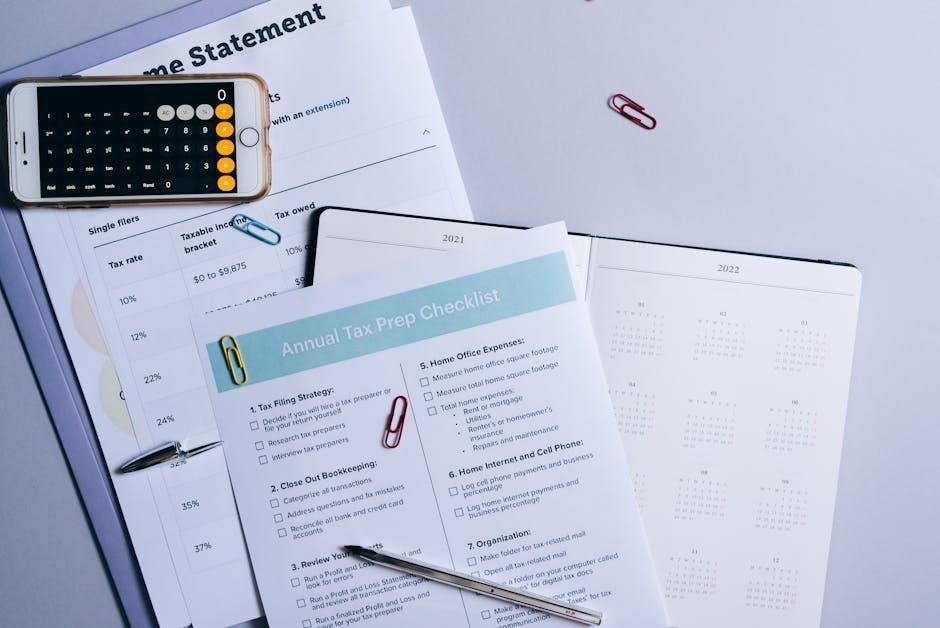concussion symptom checklist pdf

The Concussion Symptom Checklist PDF is a comprehensive tool designed to monitor and track symptoms following a head injury. It helps identify and assess physical, cognitive, and emotional symptoms, aiding in early detection and recovery management. Widely used by healthcare professionals and patients, it provides a structured approach to documenting symptoms, ensuring proper care and guidance throughout the recovery process.
Definition and Purpose
The Concussion Symptom Checklist PDF is a standardized tool designed to assess and monitor symptoms following a head injury or suspected concussion. Its primary purpose is to provide a clear and structured method for identifying and evaluating physical, cognitive, and emotional symptoms. The checklist allows individuals to rate their symptoms on a scale, typically from 0 to 6, with 6 indicating the most severe symptoms. It serves as a baseline assessment for comparing post-injury symptoms and tracking recovery progress over time. Healthcare professionals and patients alike use this tool to ensure early detection of concerning symptoms, guide appropriate medical interventions, and support safe return to daily activities. Its simplicity and effectiveness make it a vital resource for concussion management.
Overview of the Checklist
The Concussion Symptom Checklist PDF is divided into sections to systematically evaluate symptoms following a head injury. It begins with personal and injury details, including the date, time, and nature of the incident. The checklist then assesses physical symptoms such as headaches, dizziness, and nausea, cognitive symptoms like confusion or memory issues, and emotional or behavioral changes such as irritability or anxiety. Each symptom is rated on a scale from 0 to 6, with 0 indicating no symptoms and 6 representing severe distress. This structured format allows for consistent monitoring over time, helping to identify improvements or worsening conditions. The tool also highlights red flags that require immediate medical attention, ensuring timely intervention when necessary.

Importance of Using a Concussion Symptom Checklist
A concussion symptom checklist is vital for early detection, monitoring recovery, and preventing further injury. It ensures timely medical intervention and tracks progress effectively, promoting safer outcomes.
Early Detection of Symptoms
Early detection of concussion symptoms is crucial for proper management and recovery. The checklist helps identify common symptoms like headache, dizziness, confusion, memory issues, and sensitivity to light or noise. By rating symptoms on a scale, individuals can track changes over time. Baseline assessments before injury provide a reference point, while post-injury evaluations reveal deviations. Monitoring symptoms in the first 24-48 hours is vital, as worsening symptoms may indicate the need for urgent medical care. Early detection ensures timely interventions, preventing complications and promoting a safer recovery process. Regular check-ins help healthcare providers make informed decisions, improving outcomes for individuals with concussions.
Monitoring Recovery Progress
Monitoring recovery progress with a concussion symptom checklist ensures a structured approach to tracking improvements. The checklist allows individuals to document symptom severity over time, providing clear insights into recovery trends. Regular assessments help identify persistent or worsening symptoms, guiding adjustments to rest or activity levels. This longitudinal monitoring supports tailored care plans, ensuring a safe return to daily activities or sports. By maintaining detailed records, healthcare providers can make informed decisions and address potential setbacks promptly. Consistent monitoring also reassures individuals, offering a clear roadmap toward full recovery and reducing anxiety about lingering symptoms.

Structure and Components of the Checklist
The checklist includes sections for personal and injury details, physical symptoms, cognitive and emotional assessments, and a scoring system. It also incorporates tools like PCSS and RPQ for evaluation.
Personal and Injury Information
The checklist begins with personal and injury details, including the patient’s name, date of birth, contact information, and injury specifics. It records the date, time, and circumstances of the injury, such as how and where it occurred. This section also documents baseline assessments, including how the individual typically feels, and post-injury evaluations. For students, it may include monitoring over 30 minutes after the injury. This information helps establish a clear reference point for symptom tracking and recovery monitoring. Accurate documentation ensures personalized care and proper guidance throughout the healing process, making this section foundational for effective concussion management and follow-up.
Physical Symptoms Assessment
The physical symptoms assessment section of the checklist evaluates common post-concussion symptoms such as headache, dizziness, nausea, fatigue, and sensitivity to light or noise. Patients rate each symptom’s severity on a scale, typically from 0 (none) to 6 (severe). This section helps identify immediate physical distress and monitor changes over time. It also includes items like blurred vision, balance issues, and neck pain, which are critical for understanding the injury’s impact. By tracking these symptoms, healthcare providers can assess the severity of the concussion and guide appropriate rest and rehabilitation strategies, ensuring a safe and gradual return to normal activities. Regular updates help document progress and adjust treatment plans as needed.
Cognitive Symptoms Evaluation
The cognitive symptoms evaluation section assesses mental and intellectual challenges post-concussion, such as confusion, memory issues, difficulty concentrating, and slowed thinking. Patients rate symptoms like forgetfulness, mental fogginess, or difficulty with tasks requiring attention. This section helps identify impairments in brain function and track cognitive recovery. Tools like the Post-Concussion Symptom Scale (PCSS) and Rivermead Post-Concussion Symptoms Questionnaire (RPQ) are often referenced for structured assessment. Monitoring cognitive symptoms is crucial for determining when it’s safe to resume mental activities, school, or work. Healthcare providers use this data to recommend cognitive rest, adjust rehabilitation plans, and ensure a gradual return to cognitive demands, preventing overexertion and promoting full recovery. Regular updates help tailor individualized care strategies.
Emotional and Behavioral Symptoms
The emotional and behavioral symptoms section evaluates changes in mood and behavior post-concussion, such as irritability, anxiety, sadness, or emotional instability. Patients are asked to rate how these symptoms affect them, providing insight into their mental state. This part of the checklist helps identify emotional struggles that may arise, such as increased sensitivity, mood swings, or feelings of hopelessness. Tracking these symptoms is crucial for understanding the overall impact of the concussion and ensuring proper emotional support. Tools like the PCSS and RPQ often include questions about emotional well-being to guide interventions. Monitoring emotional symptoms aids in providing appropriate psychological care and promoting a balanced recovery process.
Scoring System and Scale
The Concussion Symptom Checklist PDF utilizes a scoring system to quantify the severity of symptoms, typically ranging from 0 to 6, where 0 indicates no symptoms and 6 represents severe distress. This scale allows individuals to rate their symptoms consistently, enabling healthcare providers to track changes over time. The scoring system helps identify worsening or improving conditions, guiding clinical decisions. For example, the Post-Concussion Symptom Scale (PCSS) uses a similar 0-6 grading system, while the Rivermead Post-Concussion Symptoms Questionnaire (RPQ) employs a 0-4 scale. These standardized scoring methods ensure reliability and comparability across assessments, aiding in monitoring recovery progress and determining the need for further evaluation or intervention.

Common Tools and Scales
The Post-Concussion Symptom Scale (PCSS), Rivermead Post-Concussion Symptoms Questionnaire (RPQ), and SCAT5 are widely used tools to assess concussion symptoms. These scales help track recovery and guide clinical decisions.
Post-Concussion Symptom Scale (PCSS)
The Post-Concussion Symptom Scale (PCSS) is a widely used 22-item checklist designed to assess and monitor symptoms following a concussion. Patients rate each symptom on a scale of 0 to 6, with 0 indicating no symptoms and 6 representing severe distress. The PCSS evaluates physical symptoms like headaches and dizziness, cognitive difficulties such as memory problems, and emotional or behavioral changes like irritability. It is often used for baseline assessments before the start of a sports season and again post-injury to track recovery progress. The tool is valued for its simplicity and effectiveness in identifying symptom severity, aiding healthcare professionals in making informed clinical decisions and providing appropriate care.
Rivermead Post-Concussion Symptoms Questionnaire (RPQ)
The Rivermead Post-Concussion Symptoms Questionnaire (RPQ) is a widely used, freely available tool for assessing the presence and severity of concussion symptoms. It consists of 16 questions that ask patients to rate their symptoms over the past 24 hours on a scale. The RPQ evaluates physical, cognitive, and emotional symptoms, providing a comprehensive overview of post-concussion experiences. It is simple to administer and interpret, making it a valuable resource for healthcare professionals. Regular use of the RPQ helps monitor recovery progress and inform clinical decisions. Its reliability and effectiveness have made it a popular choice for both clinical and research settings, aiding in the management of concussion-related challenges.
SCAT5 Tool Overview
The SCAT5 (Sport Concussion Assessment Tool, 5th Edition) is a standardized tool developed by the Concussion in Sport Group to aid in the evaluation and management of concussions. It is primarily used by medical professionals and qualified healthcare providers to assess athletes suspected of having a concussion. The SCAT5 includes a symptom checklist, cognitive assessment, and physical examination to evaluate concussion-related symptoms. It provides a comprehensive framework for sideline evaluations, helping to determine the severity of the injury and guide return-to-play decisions. The tool emphasizes accurate and consistent assessments, ensuring reliable outcomes for clinical decision-making and improving concussion care in sports settings.

Recognizing Red Flags and When to Seek Medical Attention
Recognizing red flags like severe headaches, neck pain, or double vision is crucial. These symptoms may indicate serious complications, requiring immediate medical evaluation and attention.
Immediate Red Flags Post-Injury
Immediate red flags after a concussion include severe headaches, neck pain, double vision, weakness, or tingling in limbs. These symptoms may signal serious complications, such as bleeding or swelling in the brain, requiring urgent medical attention. Other concerning signs are worsening symptoms, loss of consciousness, or unusual behavior. If a person experiences any of these, they should not be left alone and must seek immediate care. Delaying medical evaluation can lead to prolonged recovery or further injury. Recognizing these red flags is critical for ensuring proper treatment and preventing long-term damage. Always err on the side of caution and seek professional help if unsure about the severity of symptoms.
Progressive or Severe Symptoms
Progressive or severe symptoms following a concussion may indicate a prolonged recovery or potential complications. These include persistent headaches, increased sensitivity to light or noise, worsening dizziness, or memory problems. Emotional changes, such as irritability or anxiety, can also signal ongoing issues. If symptoms escalate or fail to improve, it is crucial to seek medical evaluation. Severe symptoms like repeated vomiting, slurred speech, or loss of coordination may point to more serious conditions, such as post-concussion syndrome. Monitoring these symptoms with a checklist helps identify when professional intervention is necessary, ensuring timely and appropriate care. Early identification of severe symptoms is key to preventing long-term effects and promoting a full recovery.

Instructions for Proper Use of the Checklist
Complete the checklist at baseline, post-injury, and during recovery. Rate symptoms on a 0-6 scale, assessing severity and tracking changes over time for accurate monitoring.
Baselines and Initial Assessments
Baseline assessments are essential for establishing a reference point before any injury occurs. The checklist should be completed by the individual under normal conditions, rating symptoms from 0 to 6 based on how they typically feel. This baseline helps identify deviations post-injury. After a suspected concussion, administer the checklist immediately, comparing results to the baseline. This initial assessment aids in detecting early symptoms and guiding immediate care. Regular monitoring, ideally every 24-48 hours, ensures accurate tracking of symptom progression. Proper baseline and initial assessments are critical for effective concussion management, enabling healthcare professionals to make informed decisions and tailor recovery plans.
Frequency of Monitoring
Monitoring frequency is crucial for effective concussion management. Initially, symptoms should be assessed every 15-30 minutes for the first few hours post-injury, especially in acute phases. For the first 24-48 hours, daily assessments are recommended to track symptom progression. As symptoms stabilize, monitoring can transition to every 2-3 days, or as needed based on changes. Long-term recovery may require weekly assessments to ensure gradual improvement. Factors such as symptom severity, presence of red flags, and individual recovery pace guide the frequency. Consistent monitoring helps prevent prolonged recovery and ensures safe return to activities, with adjustments made as symptoms evolve over time.

Interpreting Results and Next Steps
Interpreting results involves analyzing symptom scores to assess severity and progression. Higher scores indicate more severe symptoms. If symptoms worsen or persist, seek medical attention. Use results to guide recovery adjustments and ensure safe return to activities, referencing tools like the SCAT5 for professional evaluation. Adjustments should be based on individual progress and symptom improvement over time.
Understanding Symptom Scores
Understanding symptom scores is crucial for effectively using the concussion symptom checklist; Scores typically range from 0 to 6, with higher numbers indicating greater severity. Each symptom is rated individually, and the total score reflects overall symptom burden. Baseline scores, taken before injury, help compare post-injury symptom severity. Tracking changes over time allows healthcare providers to monitor recovery progress. Significant increases or persistent high scores may signal delayed recovery or complications. Scores guide clinical decisions, such as return-to-play or work, and help determine when additional medical evaluation is needed. Accurate scoring ensures personalized care and supports safe recovery. Regular monitoring is essential for optimal outcomes.
Referring to Healthcare Professionals
Referring to healthcare professionals is a critical step when concussion symptoms persist or worsen. If symptom scores remain high or show no improvement, medical evaluation is essential. Red flags such as severe headaches, double vision, or neck pain require immediate attention. The checklist helps identify when professional intervention is needed, ensuring timely care. Healthcare providers can offer specialized treatments or adjustments to recovery plans. Early referrals prevent complications and promote safer recovery. The checklist serves as a valuable tool for guiding when and how to seek further medical support, ensuring the best possible outcomes for individuals recovering from a concussion.

Tracking Symptoms and Recovery Progress
The checklist enables systematic monitoring of concussion symptoms, allowing individuals and healthcare providers to track progress and identify improvements or persistent issues over time effectively.
Longitudinal Monitoring
Longitudinal monitoring involves tracking concussion symptoms over an extended period to assess recovery progress. The checklist is used at intervals, such as immediately post-injury, 24-48 hours later, and weekly, to document changes. Baseline assessments are crucial for comparison, helping identify improvements or persistent issues. Regular monitoring allows healthcare providers to adjust treatment plans and provide personalized guidance. This approach ensures that patients receive timely interventions if symptoms worsen or linger. By systematically recording symptoms, individuals and caregivers can better understand the recovery trajectory and make informed decisions about returning to daily activities or sports. Consistent use of the checklist supports a proactive and tailored approach to concussion management.
Adjusting Activities Based on Symptoms
Adjusting activities based on symptoms is crucial for effective concussion recovery. The checklist helps identify symptom severity, guiding individuals to modify their daily routines. For example, if dizziness or headaches worsen with physical exertion, activities should be reduced. Similarly, cognitive rest is recommended if concentration or memory issues arise. Healthcare professionals use the checklist to tailor restrictions, ensuring activities align with recovery progress. Gradual resumption of activities is advised as symptoms improve, balancing rest with gradual reintroduction to normal tasks. This approach minimizes the risk of worsening symptoms and supports a safe return to work, school, or sports. Regular reassessment ensures adjustments are made as needed.

Managing Post-Concussion Symptoms
Managing post-concussion symptoms involves tailored strategies to alleviate physical, cognitive, and emotional challenges. Techniques include rest, gradual activity resumption, and targeted therapies to promote recovery and reduce discomfort effectively.
Physical Symptom Management
Physical symptom management focuses on alleviating headaches, dizziness, and sensitivity to light or noise. Rest is crucial, with gradual resumption of activities to avoid overexertion. Pain relievers, like acetaminophen, may be recommended under medical guidance. Avoiding screens and loud environments can reduce sensory overload. Gentle exercises, such as light walking, can help regain balance and strength. Monitoring symptoms through checklists ensures tailored strategies. Severe or worsening symptoms, like persistent headaches or double vision, require immediate medical evaluation. Proper hydration and a consistent sleep schedule also support recovery. Balancing rest with controlled physical activity helps manage symptoms effectively and prevents prolonged discomfort or complications.
Cognitive Symptom Management
Cognitive symptom management addresses issues like memory problems, confusion, and difficulty concentrating. Rest is essential, with a gradual return to mentally demanding tasks. Avoiding overstimulation and stress helps reduce cognitive strain. Memory aids, such as calendars or reminders, can support daily functioning. Cognitive exercises, like puzzles or memory games, may be recommended to improve focus. A quiet, low-distraction environment fosters better concentration. Patients should avoid activities requiring intense mental effort until symptoms subside. Monitoring progress through symptom checklists ensures appropriate adjustments. If cognitive difficulties persist, consulting a healthcare professional for tailored strategies is crucial. Balancing rest with controlled cognitive activities promotes recovery and reduces long-term cognitive challenges.
Emotional Symptom Management
Emotional symptoms, such as irritability, anxiety, or mood swings, are common after a concussion. Managing these involves rest, avoiding stress, and using relaxation techniques like deep breathing or meditation. Tracking mood changes in the checklist helps identify patterns and triggers. Encouraging open communication with family and friends can reduce feelings of isolation. Limiting social interactions until symptoms improve is often recommended. Professional counseling may be necessary for persistent emotional distress. Ensuring a calm and supportive environment aids recovery. Monitoring emotional well-being alongside physical and cognitive symptoms ensures a holistic approach to healing. Addressing emotional symptoms early can prevent long-term psychological challenges and promote overall well-being.
Strategies for Emotional Symptoms
Managing emotional symptoms after a concussion requires a combination of self-care and professional guidance. Techniques like mindfulness, journaling, and relaxation exercises can help reduce anxiety and irritability. Gradually reintroducing social activities while avoiding overstimulation is crucial. Establishing a daily routine can provide structure and stability. Encouraging open communication with loved ones helps address feelings of frustration or sadness. Professional counseling or therapy may be beneficial for persistent emotional challenges. Using the checklist to track mood changes allows for early intervention and personalized strategies. Ensuring adequate rest and avoiding stressful situations supports emotional recovery. A balanced approach to managing emotional symptoms promotes overall well-being and accelerates the healing process.
Strategies for Cognitive Symptoms
Addressing cognitive symptoms, such as memory issues or difficulty concentrating, requires targeted strategies. Cognitive rest is essential, involving avoidance of mentally taxing activities like screen time or complex tasks. Gradually reintroducing cognitive activities, such as reading or problem-solving, helps rebuild mental stamina. Structured routines and memory aids, like calendars or reminders, can improve organization and reduce confusion. Techniques like cognitive rehabilitation therapy may be recommended to enhance focus and processing speed. Ensuring adequate sleep and minimizing distractions supports cognitive recovery. Regular monitoring using tools like the SCAT5 or RPQ helps track progress and adjust strategies. Tailoring approaches to individual needs, under professional guidance, fosters meaningful improvement and reduces the risk of prolonged cognitive challenges.

Resources and References
Explore additional concussion management tools, including PCSS, RPQ, and SCAT5, alongside downloadable PDF guides and recommended websites for comprehensive recovery support.
Available PDF Guides and Tools
Several PDF guides and tools are available to assist in managing concussion symptoms. The Post-Concussion Symptom Scale (PCSS) and Rivermead Post-Concussion Symptoms Questionnaire (RPQ) are widely used for assessing symptom severity. The SCAT5 tool provides a comprehensive concussion assessment for healthcare professionals. Additionally, the Concussion Symptom Checklist offers a structured format for tracking symptoms over time. These resources are available for download from reputable websites and are designed for healthcare providers, athletes, educators, and patients. They include detailed instructions for use, scoring systems, and guidelines for monitoring recovery. Many organizations, such as sports medicine associations, offer these tools to support concussion management and ensure proper care.
Recommended Reading and Websites
For further understanding and management of concussions, several reliable resources are available. The Centers for Disease Control and Prevention (CDC) offers detailed concussion guidelines and tools. The National Athletic Trainers’ Association (NATA) provides resources on concussion management in sports. Websites like CDC.gov and MayoClinic.org provide evidence-based information on concussion symptoms and recovery. The Concussion Legacy Foundation and Brain Injury Association of America also offer educational materials. Additionally, academic journals and sports medicine websites publish research on concussion assessment tools like the PCSS and RPQ. These resources are essential for healthcare professionals, athletes, and caregivers seeking comprehensive guidance on concussion care.
The Concussion Symptom Checklist PDF is a vital tool for monitoring recovery, ensuring early detection, and guiding proper management. It emphasizes the importance of seeking medical advice for severe or worsening symptoms, highlighting the need for professional evaluation to prevent further complications and promote a safe return to daily activities.
The Concussion Symptom Checklist PDF is a structured tool for assessing and monitoring symptoms following a head injury. It categorizes symptoms into physical, cognitive, and emotional domains, using scales like the PCSS and RPQ. The checklist aids in early detection, tracks recovery progress, and identifies red flags for urgent medical attention. It emphasizes the importance of baseline assessments, regular monitoring, and referring to healthcare professionals when symptoms persist or worsen. By providing a clear framework for symptom evaluation, the checklist supports effective management and ensures a safe return to normal activities. Its simplicity and comprehensive approach make it invaluable for patients, caregivers, and medical professionals alike.
Final Thoughts on Effective Use
The Concussion Symptom Checklist PDF is an invaluable resource for managing concussion recovery effectively. By consistently tracking symptoms, individuals can identify improvements or worsening conditions, ensuring timely medical intervention. Proper use involves regular assessments, baseline comparisons, and open communication with healthcare providers. The checklist’s structured format simplifies symptom monitoring, making it accessible for both patients and caregivers. Adhering to its guidelines helps prevent overexertion and promotes a gradual return to daily activities. Ultimately, the checklist empowers individuals to take an active role in their recovery, fostering better outcomes and reducing long-term complications. Its user-friendly design and comprehensive approach make it an essential tool for anyone navigating concussion recovery.